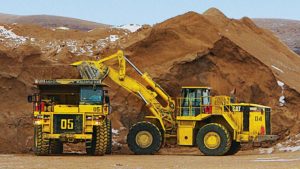
The 60,000 tonne-per-day Mount Milligan open pit, copper-gold mine is located approximately 90 miles northwest of Prince George in central British Columbia, Canada. Source: Centerra Gold Inc.
Centerra Gold Inc. [CG-TSX; CAGDF-OTC] on Wednesday February 27 announced positive news in relation to its bid to secure a vital supply of water for its Mount Milligan copper-gold mine in British Columbia.
The company said it has received a green light from B.C. regulators to access water from Philip Lake 1, Rainbow Creek and Meadow Creek for a three-year period until November 31, 2021.
Centerra will also be permitted to access water from groundwater sources within a radius of 6 km of the Mount Milligan Mine for the life of the operation.
Centerra shares advanced on the news, rising 1.35% or $0.09 to $6.74. The shares are trading in a 52-week range of $8.21 and $4.76.
The Mount Milligan Mine is one of two flagship assets in the Centerra Gold portfolio. The other is the Kumtor Mine in the Kyrgyz Republic. The company’s portfolio also includes the Oksut Gold Project in Turkey and the late stage Kemess development project in B.C.
Located about 120 km northwest of Prince George in central B.C., Mount Milligan is a conventional truck and shovel, open pit copper-gold mine. It features a copper processing plant with a design capacity of 62,500 tonnes per day.
Proven and probable reserves at the end of 2016 stood at 496.2 million tonnes, grading 0.187% copper or roughly 2 billion pounds of contained copper, and 0.36 g/t gold or 5.76 million ounces.
Centerra has been dogged by water issues in recent years, and recently attributed a dip on 2018 earnings to that fact that Mount Milligan was forced to operate at a reduced capacity for a portion of the year due to a shortage of water.
Mount Milligan experienced a drier than normal spring and summer during 2017, with a limited amount of snow melt. This resulted in lower than expected reclaim water volumes in the tailings storage facility, which is used in the mill processing operation.
In the fourth quarter of 2017, the company tried to mitigate the water shortfall by drilling additional wells to draw water from nearby aquifers. But this proved insufficient to offset the loss of water volumes caused by the limited snow melt and cold temperatures. Milling operations were shut down in December 2017, due to a lack of sufficient water resources.
As a further mitigation measure, the company moved to secure an amendment to Mount Milligan’s Environmental Assessment to allow it to pump water from a nearby lake (Philip Lake).
On Wednesday, after gaining approval for an amendment to its environmental assessment certificate, the company said it has begun the process of upgrading its water pumping infrastructure at Philip Lake 1 and Rainbow Creek and expects to be in a position to pump water from these sources prior to the spring melt, which is expected in April, 2019.
Meanwhile, the company is operating with only one ball mill. It is also maintaining its recent guidance based on the return to operating with both ball mills by the time B.C.’s snow melt gets underway.
Mount Milligan produced 47.1 million pounds of copper and 194,993 ounces of gold during 2018, an amount that was at the upper end of the company’s revised guidance in spite of the fact that the mill was temporarily shut down until early February and operated at a reduced capacity as it ramped up. The mill also operated at a reduced rate in the fourth quarter due to a shortage of water resources in the milling process.
For 2019, the company has said it is anticipating consolidated gold production to be in the range of 690,000 to 740,000 ounces and 65 million to 75 million pounds of payable copper production from Mount Milligan.
